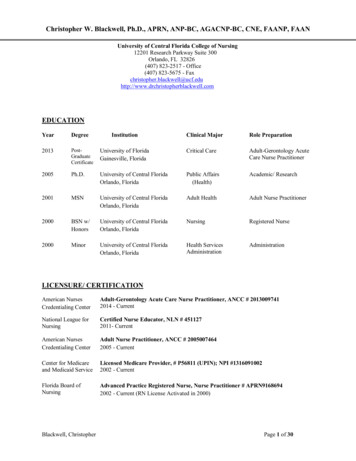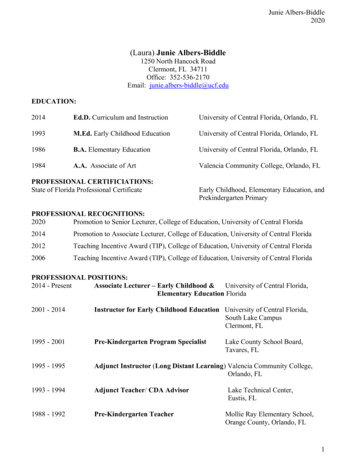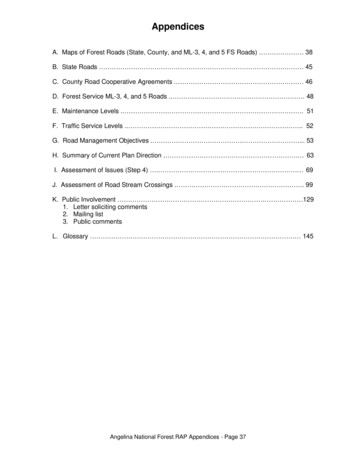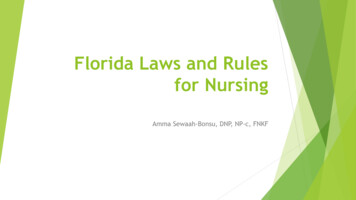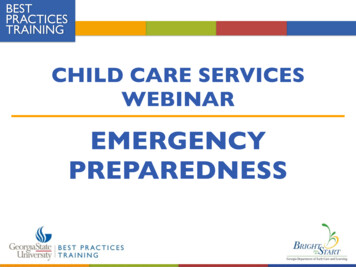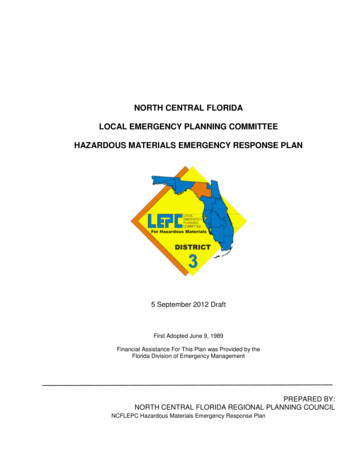
Transcription
NORTH CENTRAL FLORIDALOCAL EMERGENCY PLANNING COMMITTEEHAZARDOUS MATERIALS EMERGENCY RESPONSE PLAN5 September 2012 DraftFirst Adopted June 9, 1989Financial Assistance For This Plan was Provided by theFlorida Division of Emergency ManagementPREPARED BY:NORTH CENTRAL FLORIDA REGIONAL PLANNING COUNCILNCFLEPC Hazardous Materials Emergency Response Plan
NCFLEPC Hazardous Materials Emergency Response Plan
NORTH CENTRAL FLORIDALOCAL EMERGENCY PLANNING COMMITTEEHAZARDOUS MATERIALS RESPONSE PLANPREPARED BY:NORTH CENTRAL FLORIDA REGIONAL PLANNING COUNCILFIRST ADOPTED ON:9 June 1989DRAFT REVISION DATE:22 June 2012N:\LEPC\LEPC plan update\ncflepc plan draft 5sept2012.docxNCFLEPC Hazardous Materials Emergency Response Plan
NCFLEPC Hazardous Materials Emergency Response Plan1
RESOLUTIONWHEREAS, the enactment by Congress of the Emergency Planning and CommunityRight-To-Know Act of 1986 and enactment by the Florida Legislature of the EmergencyResponse and Community Right-to-Know Act of 1988 impose upon Local Emergency PlanningCommittees preparedness requirements for response to emergencies involving the release ofextremely hazardous substances; andWHEREAS, In compliance with this mandate, County Hazardous Materials EmergencyPlans have been developed and submitted to the Local Emergency Planning Committee tobecome a component of the regional plan; andWHEREAS, this plan is intended to provide the framework for and encourages thedevelopment of detailed standard operating procedures by local emergency responseorganizations charged with protecting the public's health and safety; andWHEREAS, this plan has been reviewed and exercised and the results of those effortshave been incorporated into this updated plan; andWHEREAS, this plan is now being submitted to the State Emergency ResponseCommission for Hazardous Materials for final approval; andNOW, THEREFORE, BE IT RESOLVED BY THE NORTH CENTRAL FLORIDA LOCALEMERGENCY PLANNING COMMITTEE THAT:The North Central Florida Local Emergency Planning Committee Hazardous MaterialsEmergency Response Plan 2012 Update is hereby adopted.PASSED AND DULY ADOPTED by the North Central Florida Local EmergencyPlanning Committee, at a regular meeting held on the th day of November 2012.draftRon Mills, ChairmanATTEST:Shayne Morgan, Vice-ChairNCFLEPC Hazardous Materials Emergency Response Plan2
NCFLEPC Hazardous Materials Emergency Response Plan3
Table of ContentsTable of Contents . 41.0 PLAN OVERVIEW AND PURPOSE. 61.1 RESPONSIBILITY FOR THE PLANNING EFFORT. 91.2 EMERGENCY PLANNING BASIS . 91.3 HAZARDS ANALYSES . 121.4 HAZARDS ANALYSIS ASSUMPTIONS . 141.5 SUPPORTING PLANS . 151.6 MUTUAL AID AGREEMENTS . 151.7 AUTHORITIES AND REFERENCES . 162.0 EMERGENCY RESPONSE ORGANIZATIONS AND RESPONSIBILITIES . 192.1 GENERAL . 192.2 LOCAL GOVERNMENT ORGANIZATIONS AND RESPONSIBILITIES . 192.3 STATE GOVERNMENT ORGANIZATIONS . 252.4 FEDERAL GOVERNMENT RESPONSIBILITIES . 282.5 FACILITY OWNERS/OPERATORS . 293.0 DIRECTION AND CONTROL. 333.1 GENERAL . 333.2 NATIONAL INCIDENT MANAGEMENT SYSTEM (NIMS) . 333.3 LOCAL GOVERNMENT ROLE . 333.4 STATE GOVERNMENT ROLE . 353.4 FEDERAL GOVERNMENT ROLE. 354.0 NOTIFICATION AND ACTIVATION . 364.1 GENERAL . 364.2 WARNING POINTS . 364.3 NOTIFICATION AND ACTIVATION . 364.4 NOTIFICATION OF THE PUBLIC . 39APPENDIX A . A-1Acronyms, LEPC Plan Distribution List, and Sample Executive Order Declaring aHazardous Materials EmergencyAPPENDIX B . B-1NCFLEPC Hazardous Materials Emergency Response Plan4
List of Extremely Hazardous Substance and Data for Hazards AnalysesNote: This is contained in electronic format in the CAMEOfm software provided by theU.S. EPA. This is located at the North Central Florida Regional Planning Council Office,2009 NW 67 Place, Gainesville.APPENDIX C . C-1Hazards AnalysesNote: This is contained in electronic format in the CAMEOfm software provided by theU.S. EPA. This is located at the North Central Florida Regional Planning Council Office,2009 NW 67 Place, Gainesville.NCFLEPC Hazardous Materials Emergency Response Plan5
1.0 PLAN OVERVIEW AND PURPOSEThe Emergency Planning and Community Right-To-Know Act (EPCRA) was passed byCongress in 1986, and is also known as Title III of the Superfund Amendments andReauthorization Act (SARA Title III). This Act requires the preparation of local hazardousmaterials emergency response plans. The State of Florida uses the eleven regional planningcouncil districts, depicted in Illustration 1-1, to perform this function. Following federallegislation, the Florida Legislature passed the Emergency Response and Community Right-toKnow Act of 1988, as amended, which establishes a fee system to fund the development ofregional and county response plans.In compliance with this mandate, the North Central Florida Local Emergency PlanningCommittee (NCFLEPC) has prepared and updated this hazardous materials emergencyresponse plan for its eleven-county region. The Committee is also actively pursuing thesuccessful implementation of its responsibilities through the programs being developed andcarried out by the LEPC and agencies of local government.The responsibilities placed on the LEPC and on local government agencies includeestablishing predetermined chains-of-command for managing local resources during ahazardous materials emergency, as contained in county plans and, if the emergency exceedslocal response capabilities, procedures on how to request state assistance. Although facilitiesthat have reported that they store or have on-site extremely hazardous substances (EHSs) inamounts over the threshold planning quantities (TPQs) are specifically addressed in this plan,a framework is established for the development of procedures to include all types of hazardousmaterials releases.A range of possible emergency situations and some measures to minimize the adverseimpacts of a toxic chemical release are also described in this plan. All local emergencyresponse organizations are encouraged to use the information contained in this plan todevelop their own hazardous materials standard operating procedures. Prior agreement onincident command systems and operating procedures is essential for the safety of localresponse agencies including law enforcement, emergency medical services, fire and rescue,and the public.Response strategies included in the plan assume the existence of specific resources andcapabilities that are subject to change over time. Therefore, it is important that the plan beregularly updated to include changes in available resources in addition to adding new facilitiesthat locate in the region.Once the threat to human life has been removed, consideration will be given to mitigatingadverse environmental consequences.NCFLEPC Hazardous Materials Emergency Response Plan6
1.0.1 IMPLEMENTATION OF THE PLANThe North Central Florida Local Emergency Planning Committee (LEPC) is not a responseagency for hazardous materials releases. Therefore, successful plan implementation dependson the information from facilities containing hazardous materials being made available in auseful form to train and equip first responders.Also important is the public's right-to-know about hazardous materials in the counties and theregion, involvement in the planning process, and knowledge of appropriate actions to take incase of an actual emergency. Another indicator of successful implementation is theinvolvement of the regulated community and its efforts to reduce the risks associated withhazardous materials.ILLUSTRATION 1-1FLORIDA LOCAL EMERGENCY PLANNING COMMITTEESNCFLEPC Hazardous Materials Emergency Response Plan7
The LEPC is actively developing and implementing programs that work towards reducing therisks associated with hazardous materials to the community and first responders. Theseprograms are aimed at three primary audiences: the regulated community, the public and firstresponders.To assist the regulated community, the LEPC has notified facilities of their potential reportingrequirements and has provided technical assistance. The LEPC has implemented a publicinformation program to inform the public about its "right-to-know". Finally, the LEPC providesaccess to training programs for first responders at the awareness and operations levels.Information contained on the Tier Two chemical inventory forms submitted by subject facilitiesto the LEPC has been entered into a computerized database for easy updating.The LEPC continues to sponsor "Community Right-to-Know Awareness" seminars for thepublic to explain what information is available, how to obtain the information, and whatliterature might be helpful in interpreting the data.With the LEPC as the lead start-up organization, the North Central Florida Regional HazardousMaterials Response Team has been established. Current Team members include Gainesville,Alachua County, Bradford County, Starke, Columbia County, Lake City, Gilchrist and UnionCounties.1.0.2 RELATIONSHIP TO COUNTY PLANSIdeally, the LEPC plan should serve as an "umbrella" to the county plans. It is important thatthe LEPC plan recognize the responsibilities placed on local government agencies, asdescribed in the county plans that provide the basis for this plan.EPCRA places a primary responsibility for the development of hazardous materials emergencyresponse plans on the LEPC. Florida emergency planning legislation places the responsibilityof actually responding to hazardous materials emergencies on local governments.Each County has a Comprehensive Emergency Management Plan (CEMP) that describes howthe County will respond to any emergency, including hazardous materials.1.0.3 DEVELOPMENT OF THE LEPC HAZARDOUS MATERIALS PLANThe LEPC plan was originally adopted on June 9, 1989 and is updated annually.The following process is used to update the plan. Issues that need to be updated in the LEPCplan are identified through the implementation activities conducted by the LEPC. These issuesare then referred to either the First Responders Subcommittee or the Public InformationSubcommittee for review and comment. The changes proposed by those Subcommittees arethen forwarded to the Plan Review Subcommittee for integration into the LEPC plan.NCFLEPC Hazardous Materials Emergency Response Plan8
The proposed plan update is then submitted to the full LEPC for review and adoption. Goalsfor plan updates include making the plan shorter by eliminating unneeded sections, moreefficiently organizing resource information, and addressing additional issues that are identifiedthrough incidents, projects and programs.1.0.4 PROCEDURES FOR PLAN REVISIONDue to numerous minor changes made throughout the plan, each update of the plan updatecompletely replaces all previous versions of the plan.1.1 RESPONSIBILITY FOR THE PLANNING EFFORTThe NCFLEPC Hazardous Materials Emergency Response Plan has been developed basedupon guidance criteria prepared by the National Response Team (NRT-1), the StateEmergency Response Commission for Hazardous Materials, and the Division of EmergencyManagement. Under contract with the state, the North Central Florida Regional PlanningCouncil provides staff support for the LEPC. Portions of the plan that address local emergencyresponse capabilities have been developed with input from local government emergencyresponse personnel. Site-specific hazards analyses were developed with input from EPCRASection 302 facility owners and operators and are based on the county plans. The hazardsanalyses (hazards identification, vulnerability analysis, and risk analysis) are included byreference only.The LEPC has responsibility for the development and maintenance of this plan. Countyemergency directors are responsible to the Boards of County Commissioners and the LEPCfor insuring that prompt and effective protective measures can and will be taken in the event ofan emergency involving the release of hazardous materials.The LEPC has the responsibility to annually revise and adopt this plan. Plan revisions willreflect changes in implementation procedures, improved emergency preparedness capabilities,and the amelioration of deficiencies identified through reviews, drills, exercises, and actualresponses.1.2 EMERGENCY PLANNING BASISThe following sections describe the North Central Florida Region, available hazardousmaterials response capabilities, hazards and vulnerability analyses that together provide thebases for the plan.1.2.1 REGIONAL DESCRIPTIONMuch of the North Central Florida Region is largely undeveloped and rich in natural areas andresources. In addition, it has been relatively untouched by the rapid growth occurring in otherparts of the state. A map of Florida's counties and LEPC boundaries is included in IllustrationNCFLEPC Hazardous Materials Emergency Response Plan9
1-1. Detailed descriptions of the counties, demographics, and climate are available from theNorth Central Florida Regional Planning Council Strategic Regional Policy Plan.The impact of the climate variables on the airborne distribution of chemicals can be calculatedusing the ALOHA software distributed by the U.S. EPA. Generally, the higher the temperaturethe greater the rate of chemicals becoming airborne. The worst case wind speed is 3.4 mph,which will cause the largest downwind plume for a given level of concern.The region consists of eleven counties covering an area of 6,813 square miles with Dixie andTaylor counties bordering the Gulf of Mexico. Inland counties include Alachua, Bradford,Columbia, Gilchrist, Hamilton, Lafayette, Madison, Suwannee, and Union.Overall, the population density is very low with a total population of around 450,000 estimatedfor 2007. Approximately one-half of the population of the region is located in Alachua County.Currently, the region's population comprises less than three percent of the state's totalpopulation. Special populations include a number of correctional institutes distributed over theregion, the University of Florida, and a concentration of medical facilities in Gainesville.Critical time variables impacting on emergency services include a large area with sparsepopulation and limited available resources. Generally the road network is operating undercapacity, with the exception of sporting events and accidents on an Interstate Highway. Sincethe formation of the North Central Florida Regional Hazardous Materials Response Team, theoverall response times have decreased in certain remote areas.Sensitive environmental areas include the Suwannee and Santa Fe Rivers, areas with a highrecharge rate to the Floridan Aquifer, and the Gulf of Mexico. Land use patterns include urbandevelopment centered around municipalities with a majority of the area classified as rural.Groundwater is the almost exclusive source of potable water.The transportation of hazardous materials occurs primarily on the highway and rail systemsdescribed below and shown in Illustration 10-1. Interstate Highways 10 and 75 provide groundtransportation to south Florida, Jacksonville, Tallahassee, and Atlanta.U.S. Highway 27 connects Gainesville and Perry and continues to Tallahassee. U.S. 90follows a route parallel to Interstate 10 and U.S. 98 parallels the Gulf coast. U.S. 301 is amajor north-south highway through the eastern portion of the region, providing access betweenthe Gainesville and Jacksonville areas. State roads 51 and 349 connect Live Oak with theGulf coast. State Road 100 passes through Lake City and Starke in its route to the AtlanticOcean.Overall, the regional road network consists of 1,101 miles of rural and 130 miles of urbanroadways. Included in this are 177 miles of interstate highways and 1,054 miles of state andcounty roads and highways.Railroad activity in the region is primarily freight transportation. Service is provided by CSXTransportation and Norfolk Southern. Passenger rail service in the region consists of twoNCFLEPC Hazardous Materials Emergency Response Plan10
routes, one north-south connecting in Waldo and the other east-west connecting in Lake City.1.2.2 SUMMARY OF HAZARDOUS MATERIALS RESPONSE RESOURCESThe North Central Florida Regional Hazmat Team has greatly expanded the capabilities andservice area cover by a timely hazmat response. Response resources are located inGainesville, Lake City, Gilchrist County, and Suwannee County. In 2012 a decontaminationtrailer was placed in service in Dixie County.A few facilities (PCS Phosphate, SiVance/Milliken, and Buckeye Florida) have on-sitehazardous materials response capabilities and are involved in a dialogue with the LEPCregarding supporting off-site response.Chapter 7 contains a description of hazardous materials response teams. Most of the largermunicipal water and wastewater treatment systems have some resources for dealing withleaking chlorine cylinders and containers.A number of public-sector and private-sector Section 302 facilities have hazardous materialsresponse capabilities and will be encouraged to enter into agreements with local responders.These teams typically are specialized in responding to a limited number of chemicals that arepresent at their facility. The hazmat team from SiVance/Milliken is actively involved in trainingwith Gainesville Fire Rescue.1.2.3 SUMMARY OF HAZARDOUS MATERIALS PROPERTIESThe chemical properties of a hazardous material are intrinsic to the substance and areindependent of facility location. Table 1-1 contains a summary of the chemical properties ofeach extremely hazardous substance identified in the eleven-county planning district.The "level of concern" (LOC) represents the estimated concentration of an extremelyhazardous substance which may cause irreversible acute health effects or death as a result ofa single exposure for a relatively short duration. The lower the LOC is, the more toxic thesubstance.The risk associated with a release is also dependent on the physical state. Gases typicallybecome airborne more readily than liquids. Gases stored under pressure also have theadditional risk of sudden release of pressure. Liquids or molten solids generally becomeairborne through evaporation. Powdered solids are likely to become airborne only if propelledinto the air by force, e.g., an explosion. The typical use of each extremely hazardoussubstance is also listed in the summary table.1.2.4 SUMMARY OF HAZARDS AND VULNERABILITY ANALYSESA hazards and vulnerability analysis is conducted for facilities that report under Section 302that they contain at any time during the year an extremely hazardous substance over thethreshold planning quantity. The analysis is based upon an on-site inspection of the facility.NCFLEPC Hazardous Materials Emergency Response Plan11
The hazards analyses are included by reference taken from the eleven county plans in theLEPC district. The hazards analyses include the name of the county, name of the facility,chemical identity, location, quantity, and nature of the hazard. The vulnerability analysesestimate the geographic areas that may be subject to concentrations of an airborne EHS atconcentrations sufficient to cause irreversible acute health effects or death to humanpopulations during a release. The vulnerable zone radius distances vary significantly with windspeed and atmospheric stability. The vulnerable zones shown represent the modeling worstcase for each release.Decisions concerning whether or not to evacuate as well as evacuation distances are incidentspecific and must be made at the time of an accidental release. An estimated vulnerable zoneshould not automatically be used as the basis for evacuation during an incident response.1.3 HAZARDS ANALYSESEPCRA provides the authority for the LEPC to request planning information necessary fordeveloping and implementing emergency response plans for hazardous materials.Comprehensive hazardous materials planning depends on a clear understanding of whathazards exist within the region and what risk they pose to its residents. To gain thisunderstanding, site-specific hazard analyses for airborne releases of extremely hazardoussubstances were prepared utilizing information collected during on-site visits to the facilities.These hazards analyses serve as the basis for developing and revising the emergencyresponse plans that are mandatory under EPCRA.The hazards analyses include known potential acute health hazards for facilities reportingunder Section 302. The plan identifies which hazards are of high priority and should beaddressed in the emergency response planning process. There are thought to be morefacilities (mainly agricultural) in north central Florida that are subject to the reportingrequirements of Section 302. Continuing programs through the LEPC have been implementedto make these facilities aware of their reporting obligations.In a hazards analysis, information includes the chemical name, maximum quantity on the site,maximum amount in interconnected vessels (vessel amount) and the vulnerable zone radiusand area for wind speeds of 3.4 miles per hour (low wind) and 11.9 miles per hour (high wind).The hazards analysis consists of the following three components: hazards identification,vulnerability analysis, and risk analysis.1.3.1 HAZARDS IDENTIFICATIONHazards identification provides specific information on situations that have the potential forcausing injury to life or damage to property. The CAMEO software from the U.S. EPA containsthe list of extremely hazardous substances and data used in the hazards analyses. A hazardsidentification includes the following information:NCFLEPC Hazardous Materials Emergency Response Plan12
Chemical identities.The location of facilities that use, produce, process, or store hazardous materialsThe type and design of chemical container or vesselThe quantity of material that could be involved in an airborne release.The nature of the hazard most likely to accompany hazardous materials spills or releases (e.g.,airborne toxic vapors or mists which are the primary focus of this guide); also, other hazardssuch as fire, explosion, large quantities stored or processed, and handling conditions.ILLUSTRATION 1-2HAZMAT TEAM COVERAGE IN NORTH CENTRAL FLORIDANCFLEPC Hazardous Materials Emergency Response Plan13
1.3.2 VULNERABILITY ANALYSISThe vulnerability analysis identifies areas in the community that may be affected or exposedduring a release, individuals in the community who may be subject to injury or death fromcertain specific hazardous materials, and what facilities, property, or environment may besusceptible to damage should a hazardous materials release occur. A comprehensivevulnerability analysis provides the following information:The extent of the vulnerable zones; i.e., the estimation of the area that may be affected in asignificant way as a result of a spill or release of a known quantity of a specific chemical underdefined conditions. Population, in terms of numbers, density, and types of individuals that could be within avulnerable zone.Private and public property that may be damaged, including essential support systemsand transportation facilities and corridors.The environment that may be affected, and the impact of a release on sensitive naturalareas and endangered species.Nearby critical facilities, including schools, hospitals, nursing homes, and other criticalpopulations that could be within a vulnerable zone.1.3.3 RISK ANALYSISThe risk analysis is an assessment for the community of the likelihood (probability) of anaccidental release of a hazardous material and the actual consequences that might occur,based on the estimated vulnerable zones. The risk analysis is a judgment of probability andseverity of consequences based on the history of previous incidents, local experience, and thebest available current technological information. It provides an estimation of the following: The likelihood (probability) of an accidental release based on the history of currentconditions and controls at the facility, consideration of any unusual environmentalconditions, or the possibility of simultaneous emergency incidents.Severity and consequences of human injury that may occur, the number of possibleinjuries and deaths, and the associated high-risk groups.Severity and consequences of damage to property.Severity and consequences of damage to the environment.1.4 HAZARDS ANALYSIS ASSUMPTIONSFacilities that use, store or produce extremely hazardous substances present in quantitiesabove threshold planning quantities will notify the State Emergency Response Commission(SERC) and LEPC as required by EPCRA.Estimates of vulnerable zones are based on Technical Guidance for Hazards Analysis,Emergency Planning for Extremely Hazardous Substances, EPA, FEMA, DOT, 1987 and uponNCFLEPC Hazardous Materials Emergency Response Plan14
the following credible "worst case" assumptions: Quantity releases: maximum quantity that could be released from largest vessel orinterconnected vessels.Rate of release to air: total quantity of gas, solid as a powder, or solid in solution isassumed to be released in 10 minutes; for liquids and molten solids, the rate is basedon the rate of evaporation (rate of volatilization).Temperature: not applicable to gases or solids as powders or in solution; for liquids,dependent on whether they are used at ambient temperature or near their boiling points;for molten solids, at their melting point.Meteorological conditions: wind speed of 1.5 meters per second (3.4 miles per hour);Pasquill atmospheric stability type F indicating little turbulence.Topographic conditions: flat, level, unobstructed terrain; use of the Briggs diffusionestimation model (1973) for open-country conditions.Level of concern: one-tenth of the National Institute for Occupational Safety andHealth's "ImmediatelyDangerous to Life and Health" (IDLH) level.The chemical facility owners and operators will notify state and local governments of anemergency as soon as possible to implement warning and protective actions.The fee system implemented through Chapter 9G-14, FAC, will provide funds for thecontinual updating and implementing of the LEPC program.1.5 SUPPORTING PLANSThe following federal, state, local and facility emergency plans are available to support theimplementation of the LEPC Hazardous Emergency Response Plan: National Response FrameworkNational Oil and Hazardous Substances Pollution Contingency PlanFlorida Comprehensive Emergency Management Plan (CEMP)Florida Statewide Mutual Aid PlanCounty Comprehensive Emergency Management Plans (CEMPs)Florida Fire Chiefs Mutual Aid Plan1.6 MUTUAL AID AGREEMENTSMany local governments are entering into formal mutual aid agreements with their neighborswith regard to emergency response assistance. The LEPC supports this effort coordinated bythe Division of Emergency Management (DEM).The LEPC is recommending the all response organizations within a county predetermine whowill serve as incident commander at a hazardous materials incident. The requirements underOSHA regulations 29 CFR 1910.120(q) specifies the training level and competencies requiredNCFLEPC Hazardous Materials Emergency Response Plan15
of the incident commander at a hazardous materials incident.The Statewide mutual aid plan can be activated in case of a disaster.1.7 AUTHORITIES AND R
2009 NW 67 Place, Gainesville. . response agencies including law enforcement, emergency medical services, fire and rescue, . The proposed plan update is then submitted to the full LEPC for review and adoption. Goals for plan updates include making the plan shorter by eliminating unneeded sections, more


